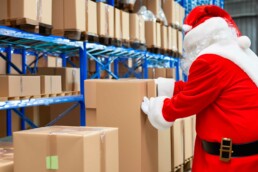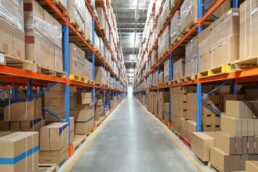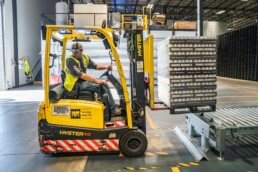5 Last-minute tips for retailers to prep for peak
5 Last-minute tips for retailers to prep for peak
Pumpkin-spice lattes firmly held in the hands of consumers signify that peak season has begun. Shoppers are already starting their holiday gift purchases despite inflation and the looming threat of a recession. Don’t worry if you haven’t had the headspace to plan for the holiday sales season. Here are five last-minute tips for retailers to prep for peak.
Diversify Your Carrier Network
Supply chain delays and carrier incidents are expected during the sales surge from October through the New Year. If you rely on a single shipping carrier, you could find yourself in a shipping and fulfillment nightmare. From weather to traffic, peak season is littered with unforeseen situations. Partnering with multiple shipping carriers allows you to pivot orders should the unexpected.
Over Communicate with Customers
Even if you haven’t stock-piled inventory, now is the time to engage your customers. Not only can you begin peak sales offerings, but now is the time to reach out to suppliers and carriers to determine realistic cut-offs and delivery deadlines. Accurate consumer details on when orders will be received are crucial to maximize peak season and ensure happy customers. Create marketing efforts to encourage early purchases, especially if your carriers are already talking to you about delays. Lastly, if you have the technology in place, now is the time to update automated e-mail correspondence regarding delivery details, returns, and how to get in touch with customer service should it be required. Keeping your customers informed before, during, and after product delivery is the best defense against a poor experience and bad reviews.
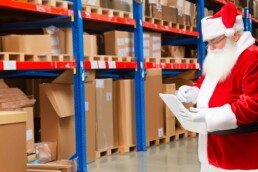
Determine Realistic Stock Availability
Reach out to your suppliers and determine realistic timelines to receive products. If they cannot get your ‘best sellers’ in stock until January, you might need to spin up a new product or engage a new supplier. Most goods are procured from Asian manufacturers because of affordability. However, now might be an opportunity to investigate some of the top manufacturers in the US. A local supplier can often deliver products in a shorter timeframe, even if it might be slightly more expensive. In general, diversifying your suppliers makes your supply chain more resilient. Find out what is possible from your existing vendors and be prepared to pivot on products or suppliers if necessary.
Boost Customer Service Efforts
Not only do sales skyrocket during peak season, but so do customer service issues and returns. Now is the time to boost efforts to streamline your customer experience efforts. While we cannot always avoid returns altogether, we can implement strategies to ensure the returns process is as seamless as possible. Refine your return policy and ensure it is visible and uses easy-to-understand language. Another last-minute tip for retailers to prepare for peak is to retrain customer service staff. Host training on how to deal with common customer service complaints reps deal with during the holidays.
- Product unavailable or out of stock
- Poor product or service
- Lack of follow-up or communications
- No first call resolution
Hire Extra Help
Even if you are late planning for peak, you will still likely need a few extra hands to deal with the sales surge. Depending on your need, make a solid effort to hire help, so your existing staff doesn’t burn out. Many retailers have standard hiring processes for the holiday season but don’t forget back office, warehouse, and service staff needs also increase.
Beginner’s Guide to Third-Party Logistics (3PL)
The world of e-commerce is always changing, therefore understanding the roll of Third-Party Logistics is integral to keeping up. In light of this our beginner’s guide to third-party logistics (3PL) will delve into the essential aspects, offering insights into fulfillment services, warehousing, and much more.
Read More…
Top Last-Minute Tip for Retailers to Prep for Peak
Partner with a 3PL
A 3PL partner can alleviate the pressures of finding a broad network of carriers. They already leverage multiple shipping services and a network of suppliers. A white-glove 3PL can introduce your business to new manufacturers and offer better shipping rates because of their current economies of scale. Furthermore, partnering with a group like Falcon Fulfillment can manage returns and refunds. We are experts in fulfillment and would love to have the chance to help your peak season soar, regardless of how late it might be.
Get in touch with our agents today to see how we can help.
Let’s Talk!
Unlock Your Business Potential with 3PL Fulfillment
Unlock Your Business’s Full Potential with Falcon Fulfillment:
Exceptional 3PL and Fulfillment Solutions
Driving Success through Quick Integration and Seamless Fulfillment
“We are very pleased with how quickly we were able to integrate with Falcon Fulfillment and we wanted to share with you that we’ve had the best Q1 in our company’s history and we could not have done it without your team and their hard work. Thank You. Looking forward to more record breaking quarters in the coming year. “
Andrew Yule, Director of Supply Chain – SOLE
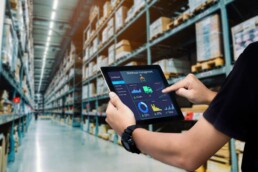
Unparalleled Order Accuracy
At Falcon Fulfillment, precision and order accuracy are at the core of our operations. With meticulous quality control measures in place, we consistently deliver flawless order processing. By employing state-of-the-art technology and skilled personnel, Falcon Fulfillment not only minimizes order errors but also leads to a reduction in returns and enhanced customer satisfaction. Consequently, when your customers receive exactly what they ordered, their trust in your brand deepens, and your business reputation strengthens.
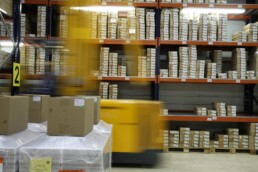
Lightning-Fast Delivery Times
Timely delivery can be a critical differentiator. Falcon Fulfillment understands this and excels in providing lightning-fast delivery times. With strategically located warehouses in Salt Lake City, UT and Louisville, KY, we achieve 96.7% delivery accuracy in two days when shipping out of both warehouse, minimizing shipping times and costs. Our partners gain a competitive edge by offering expedited and economical delivery options.

Effective Communication for Seamless Fulfillment
Clear and proactive communication is the backbone of successful fulfillment. Therefore, Falcon Fulfillment prioritizes communication with their clients through assignment of a direct account manager, thus keeping them informed at every stage of the fulfillment process. Whether it’s order status updates, inventory levels, or shipment tracking, Falcon Fulfillment’s transparent approach provides clients with peace of mind. With these real-time insights, businesses can make informed decisions and focus on their core competencies, leaving the logistics and fulfillment worries to the experts. While you focus on scaling your brand!
Why Falcon Fulfillment Stands Out When Unlocking Potential Of 3PL Fulfillment
Falcon Fulfillment goes beyond providing ordinary logistics and fulfillment services. Instead, we offer comprehensive solutions that cater to the unique needs of each client. Moreover, here are some additional aspects that set Falcon Fulfillment apart:

1. Advanced Technology Solutions:
Falcon Fulfillment leverages cutting-edge third-party logistics (3PL) technology, including cloud-based warehouse management systems (WMS) and inventory tracking software. As a result, this ensures real-time visibility and optimization of inventory management, thereby enabling businesses to meet fluctuating demands efficiently.

2. Value-Added Services (VAS):
Apart from traditional warehousing and distribution services, Falcon Fulfillment offers value-added services such as dedicated account managers, kitting and assembly, and custom/branded packaging, in-house freight brokering services, connections to numerous shopping carts, and more. These additional services allow businesses to provide a unique and tailored experience to their customers.

3. Global Reach with Customs Expertise:
Falcon Fulfillment is well-versed in international shipping and import/export processes, as 30% of our output ships to international destinations, thus providing businesses with access to a global market. Furthermore, our customs brokerage services ensure smooth cross-border operations. Additionally, we work through compliance with regard to regulations as well to avoid your packages being held at customs.

4. Scalable Solutions for Growing Businesses:
As your business expands, we scale our services accordingly, accommodating increased order volumes seamlessly. This scalability saves businesses from the hassle of continuously searching for new fulfillment partners as they grow. When you grow we grow, our base philosophy is we want to be apart of that and assist in wherever avenue possible!
Beginner’s Guide to Third-Party Logistics (3PL)
The world of e-commerce is always changing, therefore understanding the roll of Third-Party Logistics is integral to keeping up. In light of this our beginner’s guide to third-party logistics (3PL) will delve into the essential aspects, offering insights into fulfillment services, warehousing, and much more.
Read More…
Falcon Fulfillment stands as a trustworthy and efficient strategic fulfillment partner for D2C and e-commerce businesses. With an unwavering focus on order accuracy, fast delivery times, and effective communication, Falcon Fulfillment consistently results in streamlined supply chain partnerships and satisfied customers. Moreover, by leveraging Falcon Fulfillment’s comprehensive solutions, businesses can unlock growth opportunities, improve efficiency, and ultimately elevate their brand reputation.
Unlock the potential of 3PL fulfillment and propel your business towards success with Falcon Fulfillment as your trusted partner!
Want to see what Falcon Fulfillment can do for you?
Let’s Talk!
Estimating Demand Benefits Business: Advantages for Your Growth
Estimating Demand Benefits Business
As the holiday season approaches, the anticipation of Black Friday sales and Cyber Monday shopping sprees is palpable. Estimating demand benefits business, this bustling period presents both opportunities and challenges. One vital tool that can make a significant difference is estimating demand. In this blog, we’ll delve into the various benefits of estimating demand for your business, highlighting how it can be the driving force behind successful operations and growth.

Accurate Financial Forecasts
With a clear understanding of demand, you can optimize resource allocation. Estimations help you avoid overproduction and excessive inventory, which can lead to wastage and unnecessary costs. By aligning your supply chain with anticipated demand, you reduce inefficiencies, streamline operations, and enhance profitability.

Efficient Resource Allocation
In today’s environmentally conscious landscape, sustainable packaging isn’t just a trend – it’s a necessity. Embrace eco-friendly materials that resonate with your target audience. Highlighting your commitment to sustainability can also boost your brand’s appeal and foster customer loyalty.

Effective Staffing Strategies
The holiday season often presents staffing challenges, with the risk of either being understaffed or overstaffed. Estimating demand empowers you to strike the perfect balance. With insights into the expected demand for your products or services, you can ensure your staffing levels align with customer needs. This not only prevents burnout among employees but also optimizes productivity and customer satisfaction.

Strategic Marketing and Promotions
Understanding market demand is crucial for designing effective marketing and promotional strategies. When you have a clear picture of the demand for your offerings, you can allocate resources to targeted campaigns. This ensures that you are reaching the right audience at the right time, maximizing the impact of your marketing efforts and driving sales.

Enhanced Business Planning
Accurate demand estimates permeate every aspect of your business plan. Clear goals emerge, and individual departments can develop strategies that align with these goals. With demand estimates as a foundation, your business plan transforms from conjecture-driven to actionable, enabling more precise decision-making and resource allocation.

Peace of Mind and Confidence
Estimating demand provides a sense of control and peace of mind. By having a well-defined plan rooted in accurate demand forecasts, you can navigate the challenges of the holiday season and beyond with confidence. This peace of mind emanates from knowing that you are making informed decisions that are backed by data-driven insights.

Stakeholder Trust and Investor Attraction
For stakeholders and potential investors, accurate demand forecasting demonstrates competence and control. Stakeholders seek assurance that your business is equipped to navigate market fluctuations. Reliable demand estimates can bolster their confidence in your business’s ability to deliver consistent performance, which is especially vital for attracting investors and fostering partnerships.
Beginner’s Guide to Third-Party Logistics (3PL)
The world of e-commerce is always changing, therefore understanding the roll of Third-Party Logistics is integral to keeping up. In light of this our beginner’s guide to third-party logistics (3PL) will delve into the essential aspects, offering insights into fulfillment services, warehousing, and much more.
Read More…
Embrace the power of demand estimation as you steer your business toward sustained success
Estimating demand benefits your business, it goes beyond mere prediction; it is a strategic imperative that can shape the trajectory of your business. From financial planning and efficient resource allocation to confident decision-making and stakeholder trust, the benefits are clear and necessary to help your business thrive.
Need a partner to help you estimate your demand? Falcon Fulfillment can provide a solution!
Let’s Talk!
The Impact of Shipping and Delivery on E-commerce Satisfaction
E-commerce Satisfaction Through Shipping and Delivery
In the evolving world of e-commerce, customer satisfaction hinges not only on product quality and price but also on the efficiency and reliability of shipping and delivery services. Understanding the significance of these factors is crucial in enticing potential e-commerce leads. In this blog, we delve into the key takeaways from a recent survey regarding shipping and delivery experiences, and how these findings can shape your approach to enticing e-commerce businesses.
Online Shoppers Highly Satisfied with Deliveries
According to a recent survey of 1,017 online shoppers conducted by Digital Commerce 360 and Bizrate Insights, an overwhelming 77% of respondents rated their delivery experiences over the past six months at least an 8 out of 10. This high satisfaction level demonstrates that retailers are generally performing well in the realm of shipping and delivery.
The Power of Free Shipping
One key takeaway from the survey is that free shipping is the most significant factor influencing retailer selection, with 82% of respondents ranking it as their top priority. This statistic underscores the importance of offering free shipping to attract and retain customers. Additionally, 38% of shoppers consider reasonable shipping fees as crucial in their decision-making process.
The Need for Speed
Delivery speed is another essential aspect to consider. Incorporating efficient delivery solutions is not only about meeting consumer expectations but also about remaining competitive in the market. Retailers need to carefully evaluate their logistics strategies and weigh the associated costs. This evaluation should consider various factors, such as logistics management, transportation methods, and fulfillment efficiency rates.
Sustainability Matters
Environmental concerns are also influencing shopping choices, with 8% of respondents showing interest in sustainable delivery practices. A notable finding is that 30% of shoppers are willing to wait longer for orders if it means combining products for more sustainable shipping. As the awareness of eco-friendly options grows, offering such choices can set your fulfillment company apart and appeal to a segment of environmentally conscious consumers.
Inventory and Customer Service
The availability of products in stock and ready to ship is the third most important factor, cited by 59% of respondents. Keeping a close eye on inventory levels and product availability is essential. Moreover, quality customer service (52%) and customer reviews about shipping experiences (30%) contribute to a positive shopping experience and should not be overlooked.
The Impact of Shipping Costs
Concerns related to shipping costs also affect shopper behavior. For example, 46% of shoppers opt for longer shipping times to save money, while 36% abandon orders due to high shipping costs. Retailers should carefully evaluate their shipping pricing strategies. Working with a fulfillment company can drastically reduce those costs by leveraging their buying power with shipping companies. These companies can often negotiate better shipping rates than an individual business can.
Beginner’s Guide to Third-Party Logistics (3PL)
The world of e-commerce is always changing, therefore understanding the roll of Third-Party Logistics is integral to keeping up. In light of this our beginner’s guide to third-party logistics (3PL) will delve into the essential aspects, offering insights into fulfillment services, warehousing, and much more.
Read More…
Shipping and delivery are integral components of the e-commerce experience
Understanding consumer preferences and behaviors in this area is vital for e-commerce businesses to entice leads. By offering free shipping, optimizing delivery speed, and considering sustainability, your company can better meet the evolving expectations of online shoppers, ultimately driving customer satisfaction and loyalty in the competitive e-commerce landscape.
Need to up your shipping and delivery? Falcon Fulfillment can help you with your fulfillment needs. Contact us today and we will show you how easy it really can be.
Let’s Talk!
Boost E-commerce Profitability: 3 Strategies for Success
Maximizing E-commerce Profitability: Key Strategies for Success
The e-commerce domain is grappling with a hangover from its recent growth spurt. Following a two-year period of unprecedented expansion across retail sectors, the bar was set high for everyday e-commerce encounters. However, the landscape has shifted, presenting merchants with tougher challenges: heightened competition, narrower margins, and looming recession fears. As a result, e-commerce’s growth trajectory slowed in 2022, with a notable 37% of retailers falling short of their profitability goals. E-commerce profitability strategies for 2023 are going to be important.
In response, brands are tightening their belts, anticipating rougher waters ahead. Yet, amidst new trials, customer expectations remain unwavering. Both B2C and B2B buyers continue to demand seamless, omnichannel experiences akin to those offered by leading online establishments.
As we stand at the crossroads of digital commerce in 2023, a clear and effective path forward is essential.
Effective Strategies for E-commerce Profitability in Challenging Environments
In an era of heightened competition and reduced room for error, e-commerce leaders must strike a delicate balance between meeting customer preferences and ensuring profitability. Achieving this equilibrium calls for a shift away from flashy commerce technologies and towards forward-thinking initiatives driven by data and value addition.
Here are three pivotal strategies to enhance your profitability in 2023:

1. Prioritize Existing Customers over New Acquisitions
The cost of digital advertising has soared, driven by a surge in marketing investments. While certain e-commerce startups initially thrived through targeted digital ad campaigns, this model’s viability has diminished as costs escalate and the efficacy of digital ads wanes.
Instead of vying intensely for new customers in an overcrowded market, retailers are focusing on nurturing and retaining their existing clientele. A great book to consider reading is, ‘Raving Fans’ by Ken Blanchard and Sheldon Bowles. They directly speak into this philosophy of your current clientele being your most ardent supporters.
Today, profits stem from established customers, making their loyalty a key factor. Channel your marketing endeavors towards cultivating loyalty and community among your current customers. Offer quality customer service, gather first-party data, and ensure a seamless user experience across all commerce channels. Transforming a single customer into a brand advocate can yield greater returns compared to banking solely on potential prospects.
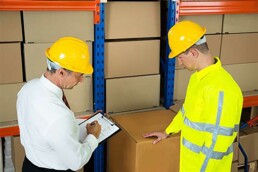
2. Elevate Inventory and Fulfillment as Competitive Advantages
While inventory management may lack the glamour of other retail operations, its significance cannot be overstated. A visually appealing website and creative branding hold value, but these aspects are futile if customers remain unaware of product availability or encounter delays in order fulfillment.
Redefine your approach to inventory and fulfillment by considering them as integral product offerings. Start by evaluating your existing fulfillment capabilities, gauging customer satisfaction, and identifying the reasons behind the abandonment of 69% of online shopping carts. Regardless of your business type, the goal is to achieve complete visibility into your inventory and maintain transparent communication regarding customer orders.
A robust fulfillment solution is essential in building customer loyalty. Fulfillment companies can serve as a vital link between you and your customers in a professional and timely manner. Therefore, select a fulfillment company that takes your business and values as seriously as you do. Fulfillment companies with dedicated account managers can help you foster customer loyalty while ensuring smooth operations for your bottom line.
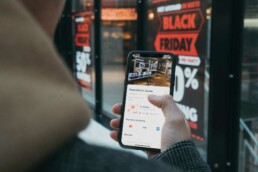
3. Harness Underrated Engagement Features
The pursuit of brand differentiation is a common theme in e-commerce leadership discussions. Yet, many brand websites often exhibit similarities. While exceptions exist, the overall customer experience on e-commerce websites tends to be homogenous—a missed opportunity to foster lasting engagement.
Elevate your website’s distinctiveness with these standout features: Utilize Conditional Content to gather user preferences through non-intrusive prompts, tailor your catalog accordingly; Establish Human-to-Human Interactions for instant connections via chat and video assistance, tapping into conversational commerce; Incorporate Dynamic Video Content to boost purchases, using videos for product showcases, addressing concerns, and guiding through sales.
Beginner’s Guide to Third-Party Logistics (3PL)
The world of e-commerce is always changing, therefore understanding the roll of Third-Party Logistics is integral to keeping up. In light of this our beginner’s guide to third-party logistics (3PL) will delve into the essential aspects, offering insights into fulfillment services, warehousing, and much more.
Read More…
Invest in Proven Profitability Strategies
Amidst tightening profit margins and the unpredictable future of retail, e-commerce leaders may understandably feel overwhelmed. To ensure continued profitability, it is crucial to embrace data-driven strategies. Specifically, focus on nurturing loyalty among existing customers, enhancing inventory management and fulfillment processes, and leveraging innovative engagement models. By adopting these strategies, your organization can optimize profitability within the ever-shifting landscape of modern e-commerce.
Let Falcon Fulfillment Show You How We Can Help You Boost Your Online Game
Let’s Talk!
Estimating Demand Methods Techniques for Accurate Prediction
Estimating Demand: Methods and Techniques
The ability to accurately estimate demand, along with its methods and techniques, is the cornerstone of effective business planning and strategy, especially during bustling periods like the holiday season. In this blog, we’ll delve into a variety of techniques and methods for estimating demand. Specifically, we’ll explore how leveraging historical data and harnessing advanced statistical analysis can empower you to predict market demand with greater accuracy and confidence.
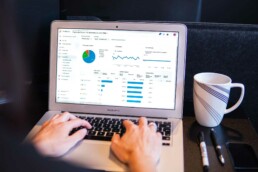
Historical Sales Analysis
One of the most straightforward methods for estimating demand is historical sales analysis. By examining past sales data, you can identify patterns that, in turn, provide insights into future trends. Although this method has limitations, such as not accounting for broader industry trends, it can still provide valuable indications of your company’s performance and potential future demand.

PPC Ad Analysis
For businesses utilizing pay-per-click (PPC) ads, analyzing metrics such as cost per conversion and ad budget can yield valuable demand estimations. By scaling these metrics against projected holiday increases, you can gain insights into the potential impact on sales. While not universally applicable, this method can be particularly effective for online businesses.

Leveraging Public Market Data

Surveys and Focus Groups
When market data is scarce or your niche is unique, engaging directly with customers through surveys and focus groups can provide valuable insights. For instance, if you find that traditional market research methods are insufficient, then using direct feedback can offer a more nuanced understanding of your audience. Consequently, these insights can help you tailor your strategies more effectively. While self-reported data has its limitations, it can serve as a starting point for understanding customer preferences and expectations.

Conducting Market Studies
Market studies involve scientific principles to test demand under controlled scenarios. While time-consuming, these studies offer robust insights into demand estimation. They are particularly useful for businesses seeking a more objective and less subjective approach.

Regression Analysis
If your business possesses substantial demand data, regression analysis becomes a powerful tool. Regardless of your level of advanced statistical knowledge, regression analysis enables you to discern relationships between variables. As a result, this insight helps you understand how changes in your products or business operations directly affect demand.

Utilizing Sales Staff Knowledge
Your sales team holds a wealth of firsthand market insights. Thus, engaging with them can offer a practical understanding of customer demand. While not as statistically rigorous, their accumulated experience can yield reasonably accurate estimations.

Consulting Outside Experts
In situations where data is unclear or contradictory, seeking input from external experts can provide much-needed clarity. These specialists offer specialized knowledge and insights, which can help you navigate complex demand estimation scenarios.
Beginner’s Guide to Third-Party Logistics (3PL)
The world of e-commerce is always changing, therefore understanding the roll of Third-Party Logistics is integral to keeping up. In light of this our beginner’s guide to third-party logistics (3PL) will delve into the essential aspects, offering insights into fulfillment services, warehousing, and much more.
Read More…
Accurate demand estimation is a critical aspect of successful business operations
By employing a range of methods, you can gain valuable insights into market trends and customer preferences. For example, historical analysis and advanced statistical techniques both empower you to make informed decisions. Consequently, you can optimize resource allocation and strategically plan for the future.
Let Falcon Fulfillment assist you with your inventory control. Contact us today, and we will help you plan for the future of your business.
Let’s Talk!
Preparing Packaging for Scaling | Expert Tips
Key Strategies For Optimizing Your Packaging For Scaling
Are you ready to take your business to new heights? Scaling up can certainly be an exhilarating journey, but it also comes with its share of challenges. One crucial aspect to consider during this expansion is your packaging strategy. Preparing packaging for scaling is undeniably an important part of the eCommerce journey. Not only does effective packaging protect your products, but it also plays a significant role in shaping your brand’s identity. With this in mind, let’s dig into some essential tips to help you prepare your packaging for scaling and ensure a smooth transition as your business grows.

1. Prioritize Versatility
When it comes to scaling, versatility is your best friend. Opt for packaging solutions that can accommodate varying product sizes and quantities. This adaptability not only streamlines your operations but also minimizes the need for constant packaging redesigns as you introduce new offerings.

2. Sustainable Materials
In today’s environmentally conscious landscape, sustainable packaging isn’t just a trend – it’s a necessity. Embrace eco-friendly materials that resonate with your target audience. Highlighting your commitment to sustainability can also boost your brand’s appeal and foster customer loyalty.

3. Leverage a Fulfillment Partner
Fulfillment companies provide a time-tested solution for packaging. Moreover, many companies can help you utilize their partnerships with packaging providers to offer a solution that fits your product best, often at a better cost. Additionally, some fulfillment providers even offer kitting solutions, meaning they can pack your kits for you as needed.

4. Brand Consistency
Maintaining brand consistency is paramount, especially as your business expands. Your packaging should reflect your brand’s values, colors, and aesthetics. A consistent visual identity instills trust in your customers and makes your products easily recognizable.

5. Scalable Designs
Think ahead and create packaging designs that can be scaled up effortlessly. This might involve using modular design elements that can be adjusted for different product lines. This approach saves time and effort while ensuring a cohesive look across your expanding range.

6. Focus on Protection
As your product volume increases, so does the potential for mishandling during transit. Prioritize protective elements within your packaging, such as cushioning and shock-absorbing materials. A damaged product not only leads to customer dissatisfaction but also adds to your operational costs.

7. Streamlined Unboxing Experience
Unboxing is undoubtedly a moment of anticipation and excitement for your customers. Therefore, make it memorable by incorporating a streamlined and visually pleasing unboxing experience. For instance, this could include personalized thank-you notes, aesthetically pleasing interior packaging, and easy-to-follow instructions.

8. Leverage Technology
While preparing your packaging for scaling consider incorporating technology into the mix, such as QR codes that link to additional product information, videos, or exclusive offers. This interactive element can engage customers and provide them with a deeper connection to your brand.
Beginner’s Guide to Third-Party Logistics (3PL)
The world of e-commerce is always changing, therefore understanding the roll of Third-Party Logistics is integral to keeping up. In light of this our beginner’s guide to third-party logistics (3PL) will delve into the essential aspects, offering insights into fulfillment services, warehousing, and much more.
Read More…
Scaling your business is an incredible achievement
It requires meticulous planning – especially when it comes to packaging. By prioritizing versatility, sustainability, brand consistency, and protection, you can ensure that your packaging not only keeps up with your business growth but also enhances the overall customer experience. Embrace these key tips, and you’ll be well-prepared to embark on your journey towards successful scalability.
Have packaging questions? Falcon Fulfillment can provide a solution!
Let’s Talk!
When Is It Time to Switch Your Fulfillment Provider?
Is It Time for a Fulfillment Provider Switch?
Key Indicators and Factors to Consider.
Your fulfillment provider is an important partner in your business. They help you get your products to your customers quickly and efficiently, which can significantly impact your bottom line. But what if your current fulfillment provider isn’t meeting your needs? We will help you answer the question: Is It Time for a Fulfillment Provider Switch?
One critical aspect that can significantly impact customer satisfaction and overall operations is the fulfillment process. Many companies opt for third-party logistics (3PL) providers to handle their fulfillment needs. While these partnerships can be beneficial, there are instances when it becomes necessary to consider changing to a new fulfillment provider.
We’ll explore the key indicators and factors that signal it’s time to make this strategic decision. If you’re experiencing slow order processing times, accuracy issues, and waning customer satisfaction with your current 3PL provider, fear not. In fact, we’ll guide you through finding a better solution tailored to your specific requirements.
Additionally, we’ll delve into the importance of scaling, technological capabilities, and value-added services when selecting a new 3PL partner. In particular, by considering these critical aspects, you can ensure a smooth transition and unlock new opportunities for growth and success in your business journey.

1.Identifying the Warning Signs:
The first step in deciding whether it’s time to switch your fulfillment provider is recognizing the warning signs. For example, slow order processing times can lead to unhappy customers and impact your brand reputation. Accuracy issues, such as order errors or inventory errors, can result in costly returns and lost sales. In other words, declining customer satisfaction might indicate that your current provider is not meeting the expectations of your customers, showing you a need for improvement.

2. Key Factors for Enhanced Fulfillment:
There are many essential factors that contribute to an efficient and reliable service. For instance, speed is critical in meeting customer expectations for prompt deliveries. We boast a 96.7% 2 day delivery when shipping out of both of our locations. Moreover, accuracy ensures that orders are fulfilled correctly, thereby reducing costly mistakes. Furthermore, a dedicated account manager can provide personal attention and address your unique needs asap.

3. Prioritizing Scalability, Communication, and Global Reach:
Every business aims for growth and expansion. So, scaling becomes a crucial consideration when selecting a new fulfillment provider. Undeniably a partner capable of accommodating your growing demands will save you from frequent switches in the future. In effect, communication is vital to ensure seamless collaboration between your team and the fulfillment provider. Moreover, if you have a global presence or plan to reach international markets, prioritize providers with a strong global reach to facilitate smooth cross-border operations. 30% of our small package output is to international destinations.

4. The Importance of Responsiveness, Transparency, and Accountability:
Outstanding customer service is built on responsiveness, transparency, and accountability. Therefore, having a direct line of communication to your account manager is key!When it comes to fulfillment, a provider’s ability to respond promptly to inquiries, provide real-time updates, and handle issues professionally can make all the difference. Transparency in operations and communication builds trust and fosters a strong partnership. Above all, accountability is a important trait in a fulfillment provider. To be sure, knowing they will take ownership of any mistakes and quickly resolve issues builds confidence in your business relationship.
Beginner’s Guide to Third-Party Logistics (3PL)
The world of e-commerce is always changing, therefore understanding the roll of Third-Party Logistics is integral to keeping up. In light of this our beginner’s guide to third-party logistics (3PL) will delve into the essential aspects, offering insights into fulfillment services, warehousing, and much more.
Read More…
Switching providers is a big decision, but it can be the right move for your business if your current provider is not meeting your needs. If slow order processing times, accuracy issues, and waning customer satisfaction are stopping your business growth, it might be time for a change. By focusing on speed and accuracy, as well as dedicated account management and scaling, you can make significant improvements. Additionally, with enhanced communication and global reach, you can find the ideal fulfillment partner that aligns perfectly with your business needs and goals.Moreover, a good 3PL provider will not only address your current pain points but also offer the flexibility and expertise required to support your long-term growth strategies. Therefore, investing time in studying and checking potential partners based on these critical factors will help in terms of improved efficiency, customer loyalty, and overall business success.
Following these tips, you can find a new fulfillment provider that will help you grow your business and exceed your customers’ expectations. Remember, making the switch to a new provider can pave the way for improved customer experiences and streamlined operations. Ultimately, this transition can contribute to your business’s success.
Want to see what Falcon Fulfillment can do for you?
Let’s Talk!
The Changing Landscape of 3PL: Bigger is not always better
Demand Down for Mega Warehouses, Up for Smaller Facilities
The Changing Landscape of 3PL: Bigger is not always better

In recent times, the logistics industry has witnessed a significant shift in warehouse trends. The changing landscape of 3PL is evident throughout the logistics industry. As the demand for e-commerce spaces declines and economic challenges persist, the era of massive warehouses exceeding one million square feet seems to be slowing down. According to a report from CBRE, there has been a 36% decrease in large-facility deals from the first half of 2022 to the same period in 2023. This drop has had an 18% impact on the overall leased industrial space during the first half of the year, aligning with experts’ predictions made in late 2022.
Demand for 3PL surges as e-commerce reduces its footprint amidst market changes
Interestingly, ecommerce companies, which were once major players in the top 100 deals, have experienced a 50% reduction in the number of transactions from January to June 2023 compared to the previous year. The average size of the top 100 industrial lease deals also decreased from 926,683 square feet to 789,471 square feet year over year.
Amid these changes, third-party logistics (3PL) firms have been on the rise, securing a third of the top 100 deals. As many ecommerce companies struggle to manage their own order fulfillment, the demand for reliable and efficient 3PL services has surged. The 3PL sector ranks second, with 34 deals, just behind the general retail and wholesale category, which claimed 34 deals.
When it comes to the most active markets for industrial spaces, Chicago leads the pack with 11 mega-deals totaling 9.6 million square feet. Following closely behind are the I-78/I-81 corridor in Pennsylvania’s Lehigh Valley (9 deals totaling 8.6 million square feet), California’s Inland Empire east of Los Angeles (9 deals totaling 8.1 million square feet), and Dallas/Fort Worth (9 deals totaling 7.3 million square feet).

Warehouse space begins to normalize
The decline in activity this year is attributed to the record-setting growth experienced in 2021 and 2022. With retailers having previously required more extensive and larger warehouses to meet the surge in pandemic-driven consumer demand and store inventory, the current domestic inventory ratios have reached the desired levels, leaving some excess capacity. As a result, leasing activity is now normalizing.
The construction of warehouses of all sizes has also experienced a slowdown due to reduced demand and difficulties in obtaining financing approvals. While smaller facilities under 100,000 square feet near population centers are in high demand, there has been insufficient growth in this segment, leading to soaring rents. The scarcity of space in these locations has driven the need for smaller buildings.
In contrast, the completed projects in the first half of the year set a record in terms of space entering the market, reaching 144.1 million square feet. However, as of June 30, only 43% of this space was occupied, down from 73% in 2022. Larger corporations, retailers, and 3PLs are slowing down the most in leasing activities. Likely due to economic uncertainty and a possible saturation of extreme activities in previous years. These entities appear content with their current warehouse stock.
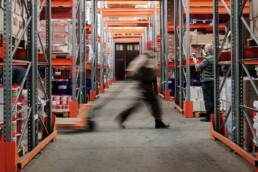
As logistics evolve so will Falcon Fulfillment
At Falcon Fulfillment we understand the evolving landscape of logistics. We recognize the growing need for a wide range of services to meet the diverse requirements of ecommerce businesses. From order fulfillment solutions, inventory management, and pick and pack services to shipping and delivery, our expertise spans the entire supply chain management process.
With a focus on smaller facilities strategically located, we offer scalable fulfillment solutions that cater to the unique demands of today’s market. Our commitment to order accuracy and quality control, paired with advanced 3PL technology solutions, ensures efficient and reliable services for our clients.
From inbound and outbound logistics to customs brokerage and international shipping, we strive to optimize every aspect of the supply chain. Additionally, our value-added services (VAS), such as kitting and assembly, multi-channel fulfillment, and dropshipping solutions, add versatility and flexibility to our offerings.
As we navigate this ever-changing logistics landscape, we remain dedicated to providing top-notch 3PL services that adapt to the needs of ecommerce businesses. From freight rate negotiation to inventory forecasting, our comprehensive approach ensures a seamless experience for our clients.
As the industry shifts towards a more dynamic and adaptable model, smaller 3PL providers play a vital role in meeting the diverse needs of ecommerce businesses. By leveraging our expertise in warehousing and distribution, fulfillment services, and supply chain optimization, we aim to deliver exceptional results and support the growth of our clients in this rapidly evolving market.
Want to see what Falcon Fulfillment can do for you?
Let’s Talk!
Minimizing Shipping Costs for your E-commerce Fulfillment
Minimizing Shipping Costs for your E-commerce Fulfillment
If you’re running an e-commerce business, shipping costs can significantly impact your bottom line. Business planning experts estimate that shipping and fulfillment charges comprise 15-20% of your total net sales. As your business grows, minimizing shipping costs without compromising quality becomes increasingly important. Minimizing your e-commerce fulfillment shipping costs can immediately affect your bottom line. Here are a few tips to help you keep your shipping costs down while still providing excellent service to your customers.

Negotiate with carriers
Many major carriers offer discounts for higher volume shippers, so it pays to shop around and negotiate for the best rates. Shipping carriers adjust their rates annually; the average rate increase per annum is about 6%. It is crucial to evaluate these changes and negotiate preferred pricing when possible. If you can establish a relationship with a carrier, you may be able to get better rates. Here are a few additional tips to consider when negotiating shipping costs with major carriers.
- Review past data and shipping negotiation outcomes: Understanding where you are starting from is necessary to have an effective conversation.
- Identify frequently used accessorial fees: These added fees include; residential fees, special handling, and signature required. Evaluate which costs you are paying most often and see if you can negotiate preferred pricing on the most used accessorial fees.
- Benchmark competitor rates and services: The best way to negotiate better shipping costs is to provide cost comparisons and offerings of competitors.
- Ask for freedom in renegotiating contracts: Don’t sign any agreements that limit your ability to start or terminate a contract before an old one has expired. Shipping charges, fees, and needs fluctuate with e-commerce regularly, so ensuring you can change carriers or services mid-contract is vital.
- Maintain all money-back service guarantees: Carriers miss the mark. When they do, you need to reclaim revenues, lost package insurance, and other refunds typically offered by major carriers.

Use flat-rate shipping
If your products qualify for flat rate shipping, you can simplify your shipping process, reduce errors, and save on costs. The benefits of using flat-rate shipping include; predictable shipping charges, carrier-supplied packaging, and the offer of free shipping with total clarity on the business costs associated with it. Flat-rate shipping also helps to make your shipping costs more transparent to customers. The drawbacks of using flat-rate shipping include; shippers can end up paying for more space than they need, no opportunities for branded packaging, and impersonal customer unboxing experiences.

Utilize multiple shipping locations
If you’re shipping large quantities of products, it may be more cost-effective to ship from various warehouses. To that end, evaluating the number of SKUs in your inventory, order volume and weight, and technology available for complete omnichannel fulfillment is critical. This is especially true if you evaluate the location of your primary sales audience far from your distribution warehouse. When choosing whether a multi-site distribution strategy will minimize shipping costs for your e-commerce, there are several factors to consider.

Utilize low-cost packing materials
There’s no need to spend a fortune on packing materials. Many e-commerce businesses now use recycled materials, such as cardboard boxes, paper packing peanuts, and bubble wrap. Furthermore, many e-commerce businesses are turning to sustainable packaging options for cost savings and to become more eco-friendly
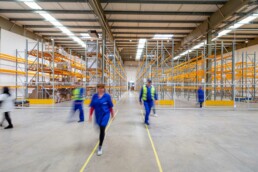
Consider third-party logistics companies
Third-party logistics companies specialize in helping e-commerce businesses reduce their shipping costs. They can provide cost-effective solutions.
- Preferred shipping rates due to bulk order volume discounts are passed to clients.
- 3PL fulfillment teams are experts in optimized shipping routes, so they save you money and time.
- 3PLs have relationships with several major shipping carriers, which gives your e-commerce access to a wider range of carriers.
- Many 3PLs offer multi-site distribution.
Additionally, when you work with a fulfillment company like Falcon, they can offer custom, sustainable, and cost-saving packaging options that don’t make you sacrifice branding opportunities. If you have consistent order volume but are not benefitting from preferred volume pricing, it might be time to consider a 3PL partner for your fulfillment needs.
Beginner’s Guide to Third-Party Logistics (3PL)
The world of e-commerce is always changing, therefore understanding the roll of Third-Party Logistics is integral to keeping up. In light of this our beginner’s guide to third-party logistics (3PL) will delve into the essential aspects, offering insights into fulfillment services, warehousing, and much more.
Read More…
Following these tips allows you to minimize shipping costs for your e-commerce without sacrificing quality. Shipping fulfillment costs can add up quickly and cut into your profitability. However, with the right strategies in place, you can ensure your customers receive their orders on time and at an affordable cost.
If you would like to learn how Falcon Fulfillment could help you minimize shipping costs get in touch with our friendly team today.
Let’s Talk!
